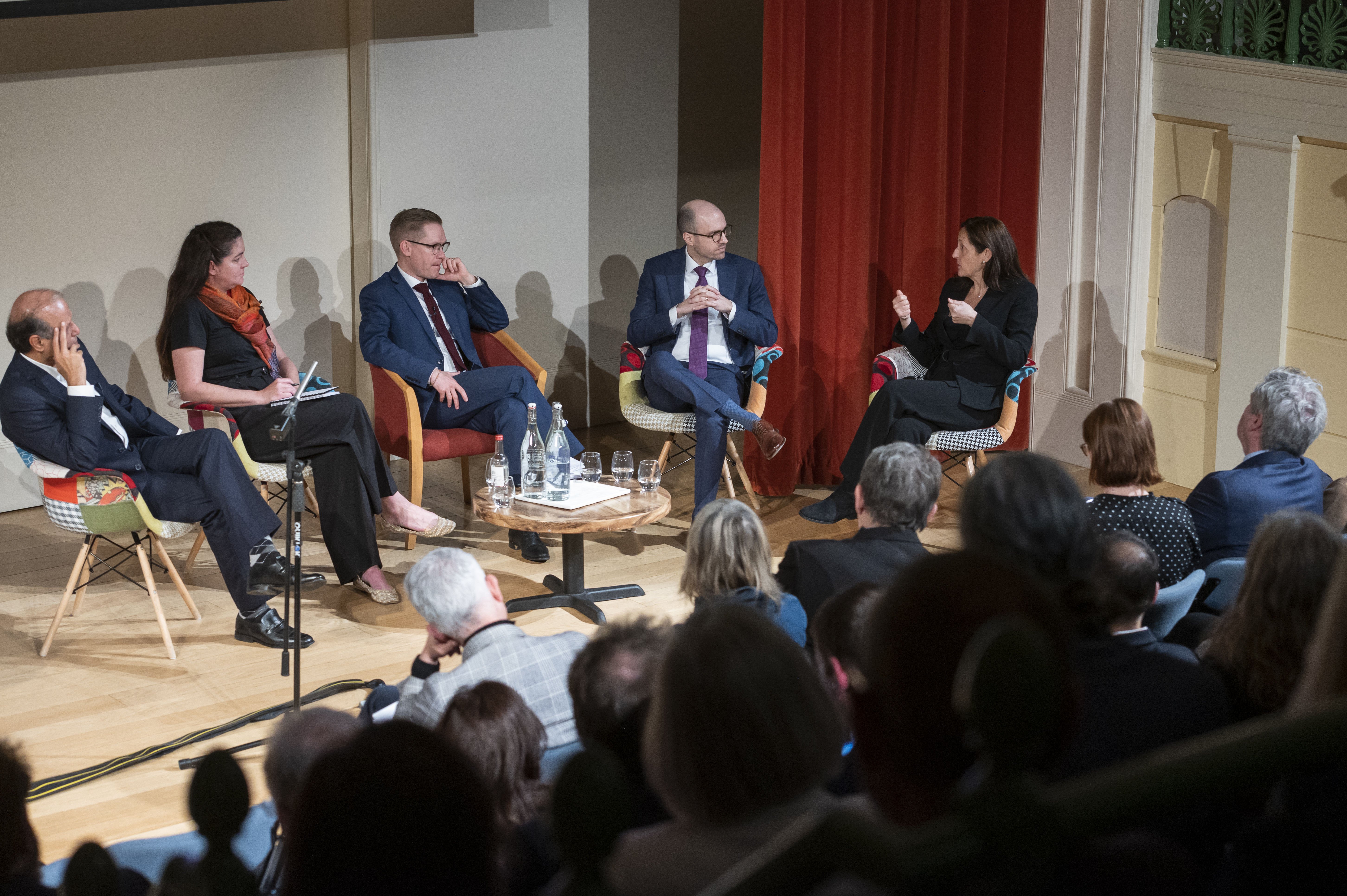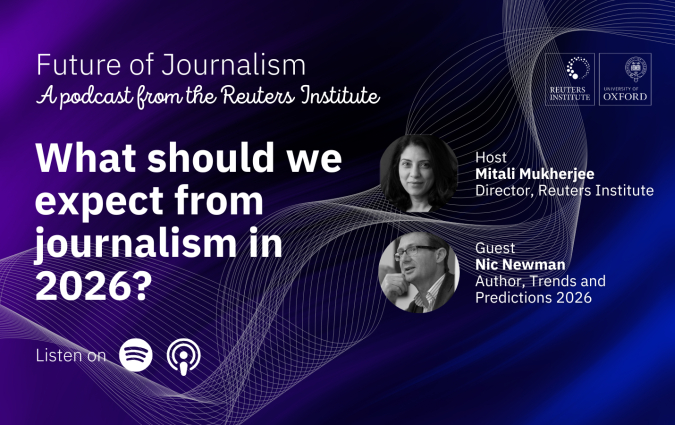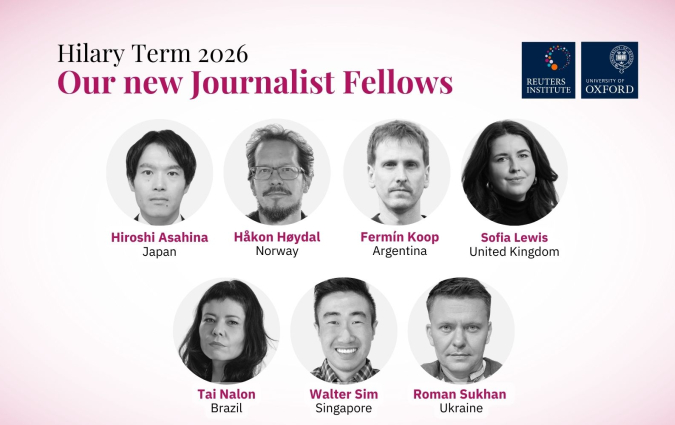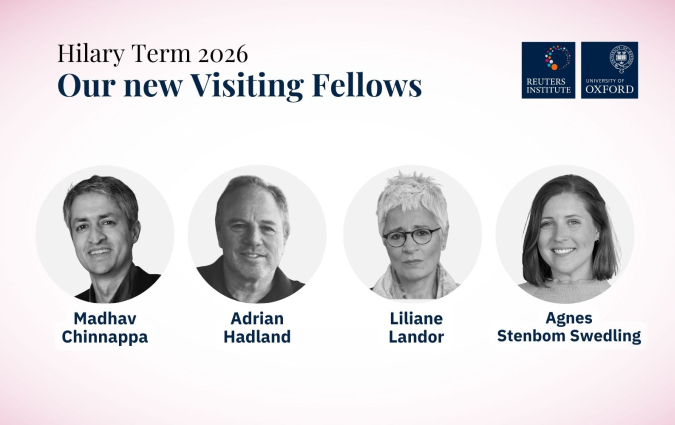“You have to give people information that helps them make proper decisions”

Rasmus Kleis Nielsen, Alessandra Galloni, Zaffar Abbas, Melissa Bell and A. G. Sulzberger discussed journalism after the 2024 Memorial Lecture. | John Cairns
“As independent journalists, we empower our fellow citizens with the information they need to make decisions for themselves,” New York Times publisher A. G. Sulzberger said in this year’s Reuters Memorial Lecture. He emphasised the enduring importance of journalistic independence in reporting, particularly when it comes to complex stories. Following the lecture, Sulzberger joined a panel chaired by our director Rasmus K. Nielsen to further delve into this topic. Also on the panel were Reuters editor-in-chief Alessandra Galloni, former Vox Media publisher Melissa Bell and Zaffar Abbas, editor-in-chief of Pakistani newspaper Dawn.
Why diversity matters
Diversity in newsrooms has increased at all levels over the last few years. Newsrooms that previously served local audiences are broadening their scope and producing their journalism more globally, even in several languages.
One of those organisations is Reuters, which now produces content in 16 different languages and employs people from dozens of countries. Galloni pointed at this diversity within the overall organisation as a force for journalistic independence. "We believe that this sort of duality of reporters who work in their own countries coupled with editing desks where you have a number of internationals is one way which sort of guarantees this independent journalism that we practise,” she said.
Similarly, the New York Times has gone from a newsroom that only covered news within the Manhattan radius towards one of the most recognisable journalism brands in the world. Sulzberger said that now they are employing more journalists from the countries they are covering than ever before.
“It used to be that we believed in the fresh eye theory that a country can only be covered by an outsider,” he said. “So in all sorts of ways we've grown more diverse and that's something that we're constantly committing ourselves to as an organisation, as the stories in the world that are front and centre continue to change.”
Abbas said that the values of large and small journalistic organisations are very similar. “If you believe in independence, if you believe in truthful journalism, you get the same kind of attacks and criticism and appreciation as a much bigger organisation,” he said. The challenges are also similar, such as coming to terms with authorities who are unhappy with your reporting. “I have learnt over a period of time not to react to the campaign against you but to continue to report and publish opinions that you believe in, and a day will come when people will start to recognise and trust you,” he added.
The subtle line between editorial judgement and an agenda
Melissa Bell outlined a difference between newspapers and news wire organisations and magazines, such as the ones Vox Media publishes. Magazines, she said, had the freedom to have “a more stated value system than independent newsgathering organisations”.
However, she added, sometimes these differences between news outlets can be confusing for audiences. She shifted the focus onto audience needs, addressing Sulzberger’s and Galloni’s views: “I think that inherently underneath what you're saying is that what audiences need is a neutral party that helps create independent journalism. But I still think that as an industry, we are confusing our audiences.”
Bell argued that there’s a very small step between editorial judgement and an agenda, which independent newspapers would say they don’t have, and many audience members don’t understand or recognise this. In magazines, however, “it’s easier for us to assert that we do have an editorial agenda.”
Sulzberger quoted his grandfather, who said that ‘when you buy the New York Times you're not just buying the news, you're buying judgement,’ and stressed that he sees editorial judgement as journalistic expertise, one that is paramount for independent journalism. It understands that the news is being reported, then contextualised, and then shared by expert journalists.
But where is the line between editorial judgement and bias? “We're not in the profession of being stenographers,” he explained. “Journalists are exercising editorial judgement. But does that editorial judgement then pass the independence threshold? Are you pursuing a story that you wish to be true, even when the facts aren't aligning with it? Are you abandoning the story when it's no longer defensible to pursue it without acknowledging any of that?”
Journalists and editors need to pursue stories independently, Sulzberger said, but they should do so with editorial judgement and using their expertise.
Galloni from Reuters sees the issue slightly differently as her organisation also caters to financial investors, in addition to other news organisations, whose only bias is making money. She sees this leg of Reuters’ business strategy as being able to inform the news product they produce as well, particularly when it comes to avoiding bias.
“It's really instructive in that if you don't give [financial investors] the facts, then they'll never come back to you,” she explained. “The way it translates into general news is that you have to give people information, explanation, context, insight, that helps them make proper decisions.” She referenced a bump in trust in news right after COVID, which we documented in our Digital News Report 2021, as people increasingly relied on news to get information about the pandemic.
AI and the future of journalism
Bell recalled the social media revolution that took place in the media industry a decade ago and drew parallels between that time and the current moment.
“There was a really interesting moment in journalism that I saw play out ten years ago when there was a lot of disruption and a lot of opportunity in the space. And I'm seeing that happen right now. We're in a transitional moment for journalism, and it's both very exciting and very frightening,” she said.
Bell said she was optimistic about AI's potential impact on journalism despite the challenges this would bring, explaining that this may be an opportunity to show audiences the value of trusted humans making journalistic decisions and that showcasing the journalistic process could reinvigorate people’s relationship with journalism. One of the biggest challenges she sees is communicating the value of journalism to audiences who have given up on it and are instead relying on unreliable sources for information.
“People are seeking out information and I think they don't think journalism can provide it,” she said later, adding this is leading audiences to turn to YouTube creators or influencers rather than journalistic news sources. “I think it's the role of many of us in this industry to think about how we reach those who are not being reached right now,” she said.
Journalism in the era of Trump 2.0
María Ramírez, deputy managing editor of elDiario.es, asked to what extent Donald Trump is a threat for democracy and the free press compared to his first term as president. Sulzberger responded by stating that the role of the press is to ask the right questions and provide context to voters: what did he do in office? What are his stated plans? Who are the people he is putting around him? What did he learn from his last term about how to effectively wield the powers of the office?
“When you get that whole picture together, he is clearly running on a more overtly anti-democratic platform than any major party candidate in well over a century. There's just no disputing that,” he said. “America will vote the way it votes. Our job is to make sure it has all the information that we can humanly possibly give them in context.”
Another question about journalism and Trump came from Edward Roussel, head of digital at Britain’s The Times and Sunday Times, who asked about criticism towards the New York Times regarding editorialization and how the organisation is thinking about editorial discipline if there were to be another Trump victory.
Sulzberger responded by stating that Trump’s defiance of norms actually created a positive disruption in newsrooms as now they had to move away from previously held journalistic conventions that perhaps did more harm than good. Now journalists are more likely to take with a grain of salt whatever whoever is at the presidential podium says.
Sulzberger also took aim at ‘media Twitter’ and how it shaped Trump coverage: “Media Twitter was perhaps the most insidious and self-destructive force in our industry because you took a profession where anytime you see a pack of reporters all staring over there, that's where the story is. And media Twitter taught us a different lesson, which is anytime you see a pack of reporters staring over here, yell it louder,” he said. “It probably took our industry a little too long to realise that media Twitter was this very intense force for intellectual conformity in our profession.”
The bottom line
Three key points drawn out by the lecture and the debate, our Director Rasmus Nielsen said, are the importance of the journalistic process in creating value, the feeling among industry leaders that the public does not understand this process, and that the value of what journalists do is only realised in connection with the public. The journalistic process, including editorial independence or a set of acknowledged editorial principles, is seen by figures in the industry as a key way to ensure the quality of reporting, but this is not always valued by audiences.
“It's pretty clear from the conversation here that we see a lot of the value being created in the process, but the public doesn't necessarily recognise that value or even have a sense of how that process adds value to it,” Nielsen said. This is a core challenge for the news media to address, particularly when new developments such as generative AI and a year with so many elections threaten to create more distrust amongst audiences.
In every email we send you'll find original reporting, evidence-based insights, online seminars and readings curated from 100s of sources - all in 5 minutes.
- Twice a week
- More than 20,000 people receive it
- Unsubscribe any time






